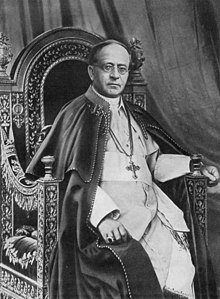Pius XI
|
Pope Pius XI |
|
|---|---|
| Bishop of Rome | |

Pius XI in 1930
|
|
| Papacy began | 6 February 1922 |
| Papacy ended | 10 February 1939 |
| Predecessor | Benedict XV |
| Successor | Pius XII |
| Orders | |
| Ordination | 20 December 1879 by Raffaele Monaco La Valletta |
| Consecration | 28 October 1919 by Aleksander Kakowski |
| Created Cardinal | 13 June 1921 by Benedict XV |
| Personal details | |
| Birth name | Ambrogio Damiano Achille Ratti |
| Born |
31 May 1857 Desio, Lombardy-Venetia, Austrian Empire |
| Died | 10 February 1939 (aged 81) Apostolic Palace, Vatican City |
| Previous post |
|
| Motto |
Raptim Transit (It goes by swiftly Job 6:15) Pax Christi in Regno Christi (The Peace of Christ in the Realm of Christ) |
| Signature |  |
| Coat of arms |  |
| Ordination history of Pope Pius XI | |
|---|---|
|
Priestly ordination
|
|
| Date of ordination | 20 December 1879 |
|
Episcopal consecration
|
|
| Principal consecrator | Aleksander Kakowski |
| Co-consecrators |
Józef Sebastian Pelczar Stanisław Kazimierz Zdzitowiecki |
| Date of consecration | 28 October 1919 |
|
Cardinalate
|
|
| Elevated by | Benedict XV |
| Date of elevation | 13 June 1921 |
|
Bishops consecrated by Pope Pius XI as principal consecrator
|
|
| Oreste Giorgi | 27 April 1924 |
| Michele Lega | 11 July 1926 |
| Alfredo Ildefonso Schuster | 21 July 1929 |
|
Papal styles of Pope Pius XI |
|
|---|---|
 |
|
| Reference style | His Holiness |
| Spoken style | Your Holiness |
| Religious style | Holy Father |
| Posthumous style | None |
Pope Pius XI, (Italian: Pio XI) born Ambrogio Damiano Achille Ratti (Italian pronunciation: [amˈbrɔ:dʒo daˈmja:no aˈkille ˈratti]; 31 May 1857 – 10 February 1939), reigned as Pope from 6 February 1922 to his death in 1939. He was the first sovereign of Vatican City from its creation as an independent state on 11 February 1929. He took as his papal motto, "Pax Christi in Regno Christi," translated "The Peace of Christ in the Kingdom of Christ."
Pius XI issued numerous encyclicals, including Quadragesimo anno on the 40th anniversary of Pope Leo XIII's groundbreaking social encyclical Rerum novarum, highlighting the capitalistic greed of international finance, the dangers of socialism/communism, and social justice issues, and Quas primas, establishing the feast of Christ the King. The encyclical Studiorum ducem, promulgated 29 June 1923, was written on the occasion of the 6th centenary of the canonization of Thomas Aquinas, whose thought is acclaimed as central to Catholic philosophy and theology. The encyclical also singles out the Pontifical University of Saint Thomas Aquinas, Angelicum as the preeminent institution for the teaching of Aquinas: "ante omnia Pontificium Collegium Angelicum, ubi Thomam tamquam domi suae habitare dixeris" (before all others the Pontifical Angelicum College, where Thomas can be said to dwell).
To establish or maintain the position of the Catholic Church, he concluded a record number of concordats, including the Reichskonkordat with Germany (Germany's betrayals of which he condemned four years later in the encyclical Mit brennender Sorge ("With Burning Concern")). During his pontificate, the longstanding hostility with the Italian government over the status of the papacy and the Church in Italy was successfully resolved in the Lateran Treaty of 1929. He was unable to stop the persecution of the Church and the killing of clergy in Mexico, Spain and the Soviet Union. He canonized important saints, including Thomas More, Petrus Canisius, Konrad von Parzham, Andrew Bobola and Don Bosco. He beatified and canonized Thérèse de Lisieux, for whom he held special reverence, and gave equivalent canonization to Albertus Magnus, naming him a Doctor of the Church due to the spiritual power of his writings. Pius XI created the feast of Christ the King in response to anti-clericalism. He took a strong interest in fostering the participation of lay people throughout the Catholic Church, especially in the Catholic Action movement. The end of his pontificate was dominated by speaking out against Hitler and Mussolini and defending the Catholic Church from intrusions into Catholic life and education.
...
Wikipedia
